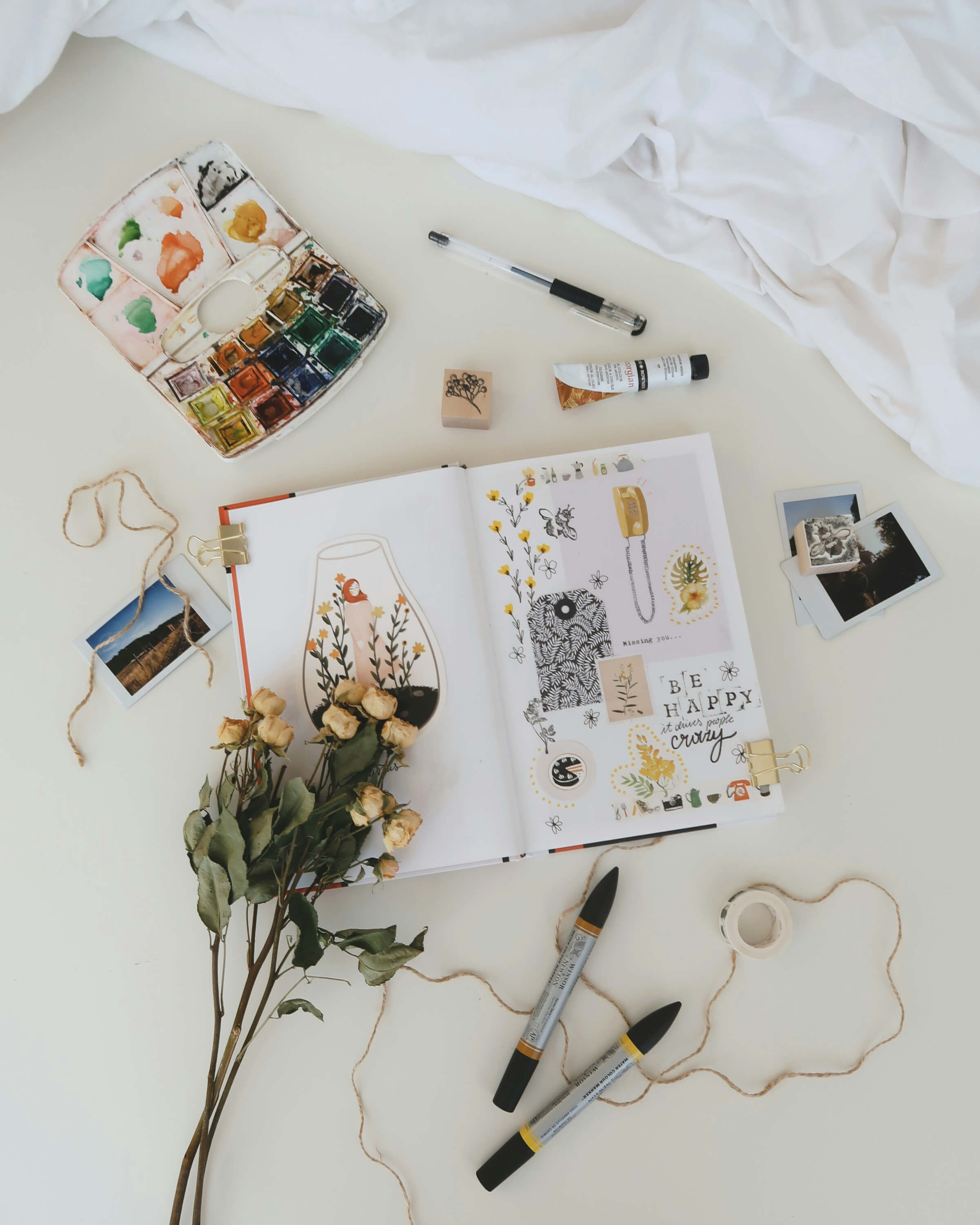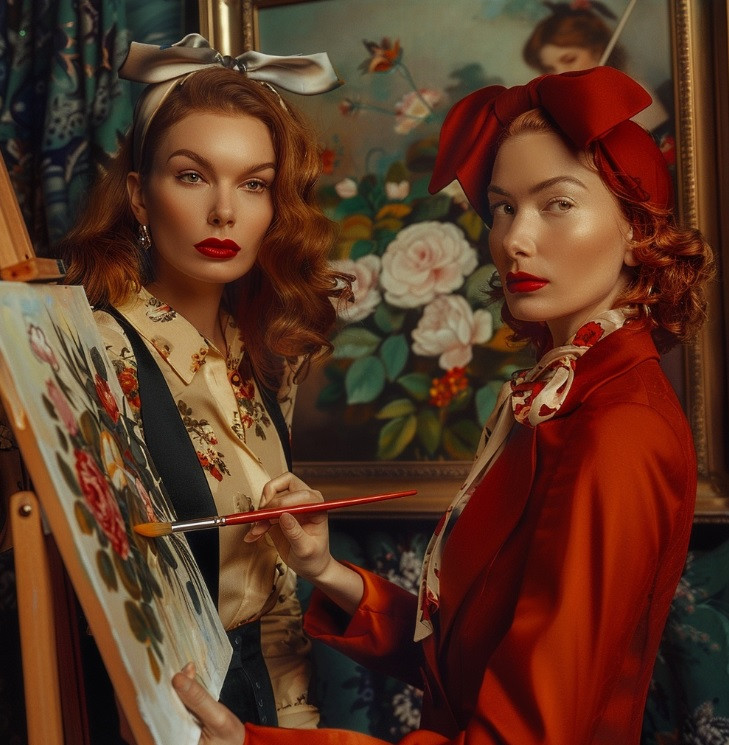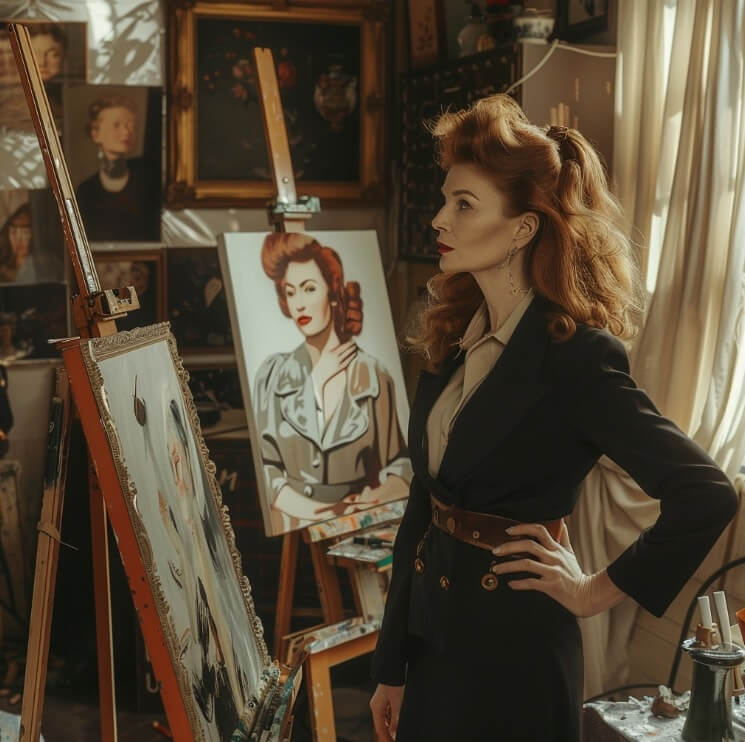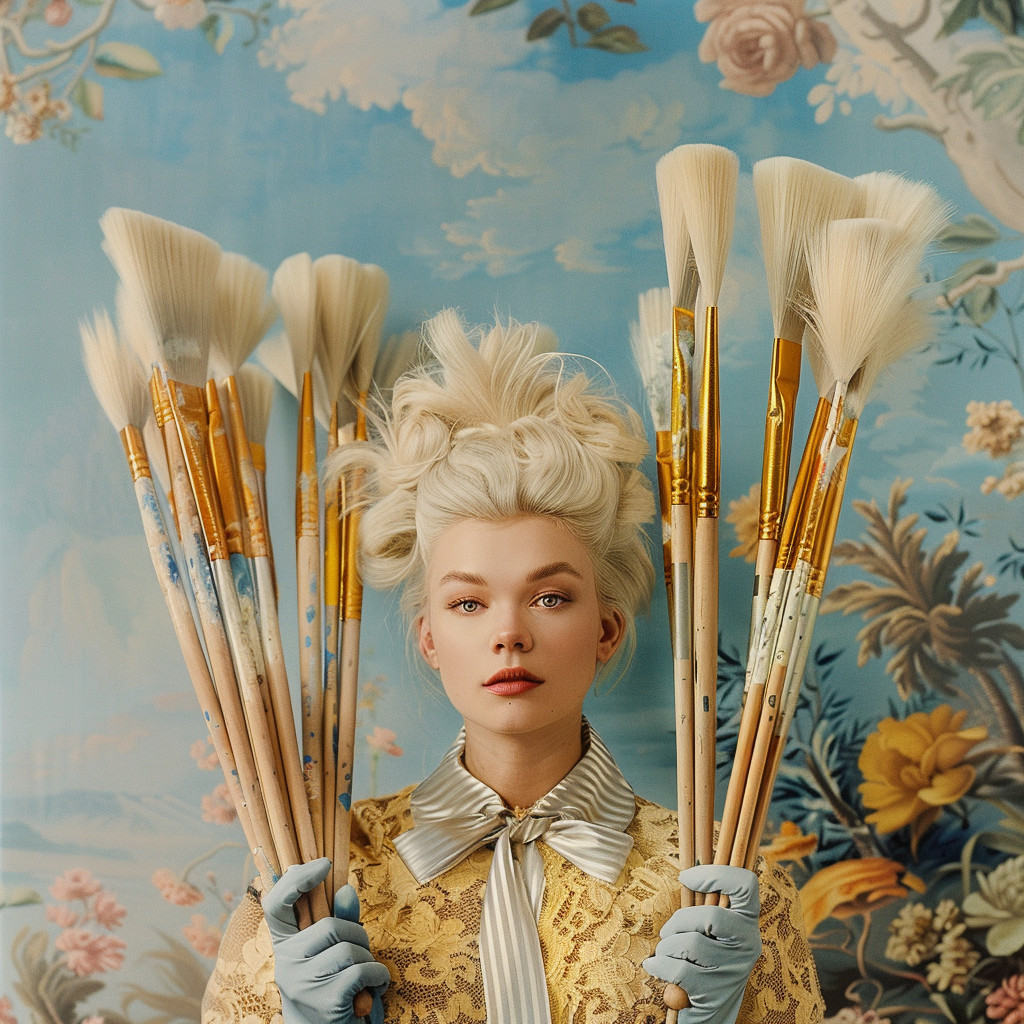 The Power of Keeping a Creative Journal
The Power of Keeping a Creative Journal We all know that finding moments of calm and introspection can sometimes feel like a luxury. We also know it’s essential for our mental well-being and creativity.
So, where do you start? For me, keeping a creative journal is a practice I have re-embraced.

Stress Relief Through Creative Expression
We all experience stress, but how we manage it can make a world of difference.
Starting a creative practice can be a source of stress itself if you don't know where to begin. As a creative, I struggle as well. Sometimes I don't "feel" like working on my current art series, or am afraid of finishing off a piece because I might, well, screw it up! And sometimes, we just don't feel like getting off the sofa because we are just mentally beat!
A creative journal provides a private, judgment-free space where you can just PLAY.
Whether you’re scribbling down errant thoughts, sketching out scenes, or pasting in colorful clippings, the process of journaling itself can be incredibly soothing.
Written Entries
I like to start by writing about my day. You can try it yourself- Let your thoughts flow freely without worrying about grammar or structure. Reflect on what made you happy, what troubled you, and what you hope for tomorrow.
(Writing can help you process your emotions, making stressors feel more manageable.)
Drawings and Doodles
Integrate art into your journaling. Simple sketches can serve as a visual expression of your feelings. You don’t need to be an artist; even abstract doodles can help offload stress.
Self-Discovery Through Reflection
A creative journal isn’t just about stress relief. After doing this practice for a while, you will find it’s a tool for self-discovery. What this looks like is different for everyone. Sometimes I look at my journal entries a year later and find them to be such a good indicator on how far I've come as well as where I haven't progressed. I also find it interesting to see the things that peaked my interest then as opposed to now. It's like looking at a progression of your own personal history.
A Few Ways to Start Reflective Entries:
Include sections where you explore your values, goals, and aspirations. Ask yourself reflective questions: What do I truly want out of life? What are my biggest strengths? Where do I see myself in five years? Returning to these entries can offer valuable insights and highlight personal growth.
Other Journal Entry Types:
Idea Exploration
Our minds are treasure troves of brilliant ideas. You may be thinking, "oh sure!" but trust me they are. You will notice while reflecting on past entries that you are a powerhouse of ideas!
Record these flashes of inspiration, ensuring they don’t slip away unnoticed.
Example: Business concepts, story ideas, or a new hobby to try, WRITE it DOWN!
Mixed Media, Images and Clippings:
Experiment with different materials—paint, washi tape, textured paper. Add photographs, magazine cutouts, or snippets from interesting articles. The tactile experience of working with diverse media can ignite your creativity and make journaling even more enjoyable.
Combining text and images can more easily tell your story without the pressure of having to write everything down.
Getting Started
All you need is a journal and few basic supplies.
Plan a trip to a local craft store or even Amazon to get yourself started. (hint: "art journal supplies" should do the trick for your search.)
Happy journaling!

When you step into a well-decorated home, something magical happens: you instantly feel the essence of its owners, the warmth of their personalities, and the creativity that makes the space uniquely theirs. Decorating your home to reflect your personality is more than just an aesthetic choice – it's an expression of who you are. Let's delve into the importance of personalized home decor and a few tips to infuse your living space with your own character.
Why Personalization Matters
1. Personal touches inspire a sense of belonging and instill peace.
Your environment has a profound effect on your emotions and overall well-being.
A home that resonates with your personality becomes your sanctuary – a place where you feel comfortable, relaxed, and genuinely yourself.
2. Decorating is a form of self-expression, like fashion or art.
It allows you to showcase your tastes, passions, and values.
Every choice, from color schemes to furniture styles, builds a narrative about who you are without uttering a single word.
3. Functionality & Comfort is Key
Personalized decor isn't just about looks; it's about creating a functional and comfortable living environment tailored to your needs.
An introspective decorating process helps you understand what designs and setups work best for your lifestyle.
4. Memories & Nostalgia
Incorporating items and styles that hold sentimental value enriches your space with stories and memories.
These items serve as visual reminders of meaningful moments, places, and people in your life, making your home truly irreplaceable.
Tips for Decorating to Reflect Your Personality
1. Discover Your Style: Before diving into decor, take time to understand your unique style preferences. Are you drawn to minimalist designs, vintage elements, or modern chic? Explore various styles and identify what resonates with you.
2. Color Palette: Colors profoundly impact mood and perception. Choose hues that reflect your personality – lively and vibrant colors for extroverted, energetic spirits, or soft, neutral tones for a calm, introspective vibe.
3. Personal Artwork & Souvenirs: Adorn your walls with artwork that speaks to your soul and displays photos and memorabilia from your travels and experiences. These pieces tell your story and add a deeply personal touch to your home.
4. Incorporate Hobbies & Interests: Whether it's a well-stocked bookshelf, a music corner, or a crafting space, integrate areas that reflect your hobbies and interests. These elements make your home a living extension of your passions.
5. Mix Old & New: Don't be afraid to mix contemporary designs with cherished heirlooms. This blend of old and new adds layers to your decor and reflects a multi-faceted personality.
6. Mindful Furniture Selection: Choose furniture that not only looks good but feels right. Think about how you use each piece daily and its contribution to your comfort and functionality.
7. Plants & Nature: Bring the outdoors in by incorporating plants and natural elements. They add life, fresh air, and a touch of nature's beauty to your home.
Your home is an extension of yourself – a canvas where you can paint your personality in myriad colors and designs. Thoughtfully decorated spaces can function as personal sanctuaries that inspire, rejuvenate, and reflect who you truly are. So, unleash your creativity, trust your instincts, and transform your house into a home that's uniquely you.
Would you like further tips, personalized advice, or professional decorating services? "GET YOUR FREE GUIDE TO TRANSFORMING YOUR INTERIOR SPACE TODAY AND BE A PART OF OUR CREATIVE COMMUNITY!"
Share your favorite personalized decor ideas in the comments below!

I am taking some time today (before a painting class :) to re-assess my daily routine and make sure I allow time for the "me" things that keep me healthy. This will undoubtedly mean getting up earlier (not my strong suit) to accomplish.
As women take on SO MUCH- probably because we are the ultimate multi-taskers and believe we can handle it. We usually don't see the effects of stress until they rear their ugly head and, cause us even more stress. I strongly believe in these self "check-ins".
We all know it's crucial for women to manage stress effectively to maintain overall health and quality of life. After all, it is a privilege to be here and what's the point if we aren't enjoying ourselves?
Stress can have far-reaching effects on our life, impacting both our emotional well-being and physical health, as well as the well-being of the people around us. Chronic stress can lead to issues such as anxiety, depression, digestive problems, heart disease, sleep disturbances, and weakened immune function.
I highly recommend taking five minutes to check in with yourself today. Here are ten practical strategies to alleviate stress and improve your well-being :
1) Practice mindfulness meditation daily to foster a sense of calm.
I had the honor of working with this lovely lady years ago and just love her daily inspiration! https://www.one-now.com/
2) Engage in regular physical exercise to release endorphins.
3) Prioritize a balanced diet rich in nutrients.
4) Ensure you get adequate sleep by maintaining a consistent bedtime routine.
Creating the best sleep routine involves establishing a set of consistent habits and environments that promote optimal rest and rejuvenation. Here are some ideas:
Go to bed and wake up at the same time every day, even on weekends. This helps regulate your body's internal clock and can improve the quality of your sleep.
Engage in calming activities an hour before bed. This could include reading a book, taking a warm bath, practicing meditation or deep breathing exercises, or listening to soothing music. Avoid stimulating activities such as watching TV or using electronic devices.
Make your bedroom conducive to sleep. Keep the room cool, dark, and quiet. Invest in a comfortable mattress and pillows, and use blackout curtains or a white noise machine if needed.
Reduce blue light exposure from screens in the evening. Consider using blue light blockers or a screen filter, and opt for dim, warm lighting as bedtime approaches.
Avoid large meals, caffeine, and alcohol close to bedtime. These can disrupt your sleep cycle and overall restfulness.
Physical activity during the day can help you fall asleep more easily at night. However, try to finish exercising at least a few hours before bedtime.
If you need to nap, limit it to 20-30 minutes and avoid napping late in the afternoon.
Get plenty of natural light during the day, which helps maintain a healthy sleep-wake cycle. Aim to spend time outside or in bright environments, especially in the morning.
Use a sleep diary or a sleep tracking app to monitor your sleep patterns. This can help identify and address any issues.
5) Manage your time effectively to prevent overwhelm.
Time blocking involves splitting your day into blocks of time, each dedicated to a specific task or group of tasks. This helps you focus on one thing at a time and reduces the likelihood of multitasking, which can often lead to decreased productivity. Schedule your blocks based on your natural energy levels, placing more demanding tasks during peak energy periods.
Use productivity apps and tools to streamline your tasks and set reminders. Tools like Trello, Asana, or even simple calendar apps can help you keep track of deadlines and project progress. Automation tools can handle repetitive tasks, freeing up your time for more critical activities.
6) Connect with friends and family to build a support network.
Start a bi-weekly check-in with a best friend or family member over anything on this list!
7) Take breaks from screens and social media.
8) Practice deep breathing exercises to reduce tension.
There are many types of breathing exercises.
Try Diaphragm breathing to get you started:
1. Sit or lie down comfortably.
2. Place one hand on your chest and the other on your belly.
3. Inhale deeply through your nose, allowing your belly to rise while keeping your chest still.
4. Exhale slowly through your mouth, feeling your belly fall.
5. Repeat for 5-10 minutes.
9) Spend time in nature to recharge.
Nature has a calming effect on the mind, reducing stress, anxiety, and depression. Simply being outdoors can elevate your mood and enhance overall mental well-being.
10) Take up a creative practice such as painting, writing, or playing music to channel your stress into a productive and enjoyable activity.
Being creative doesn't have to mean "creating your masterpiece " or even being good at a craft. Creativity helps shift your focus away from stress-inducing thoughts and offers a much-needed mental break, promoting relaxation and mindfulness. Next time you're feeling overwhelmed, consider picking up a paintbrush or jotting down your thoughts—it is the perfect therapy for your mind.
I have a few resources for you from my own creative support community:
Incorporate these strategies into your daily routine, and you will significantly reduce the harmful effects of stress and cultivate a healthier, more balanced lifestyle. Now, on to my art class to decompress and learn something new!

Comparing oneself to other artists can be a slippery slope, detouring one's artistic journey.

Why create of doubt and insecurity within yourself by comparing yourself to other artists?
Each artist has a unique voice, style, and approach to their craft, and it is this diversity that enriches us in the art world! Rather than falling into the trap of comparison as an artist, focus on fostering a supportive community that uplifts and celebrates these differences. In doing so, you will not only nurture your own creative spirit, but contribute to a more vibrant, inclusive, and collaborative artistic ecosystem.
I know first hand how important having other artists in my life is. We support each other and feed off of each other's inspiration. It can be a lonely world creating, marketing, and putting yourself out there in the public eye. Connecting with other creatives is an extended part of human experience and can greatly help you overcome isolation by sharing your craft.
Here some ways you, as an artist, can positively support each other and promote a culture of inclusivity and mutual growth:
1. Share Knowledge and Resources: Offer tips, tutorials, or helpful resources that have aided your journey; this can immensely benefit peers who might be facing challenges you’ve once tackled. This can include best practices for business, networking, and creative skills.

2. Provide Constructive Feedback: Engage in meaningful critique sessions that aim to uplift and improve each other’s work with your group. Always ask permission before providing feedback. "I noticed something about this work and wondered if you are ok with my feedback" is better than offering unsolicited advice unless you have an established relationship with this person as an artist. Do not focus on flaws, but rather opportunities or positive suggestions. Art is personal and can be a hard thing to accept criticism of.
3. Celebrate Achievements: Publicly acknowledge and celebrate the successes and milestones of fellow artists. This reinforces a culture of support and recognition.
4. Organize Joint Events or Shows: Join forces to create collaborative artwork or exhibitions, which can help blend different styles and audiences. Even if you don't sell anything, your time together will be so valuable! (and fun) You can introduce each other to potential buyers and business people at these events, thus raising visibility for you all and possibly leading to new show opportunities.
5. Engage in Skill Exchanges: Set up skill exchange workshops where artists can teach each other different techniques or aspects of their craft, enriching everyone’s skill set. For example: If you are a collage artist? Learn some new painting techniques from an acrylic artist in your group! Musicians, writers, gardeners! You have so much to learn from each other!
6. Promote Each Other's Work: Use your platforms, whether social media, websites, or newsletters, to promote the works of other artists, helping to expand their reach.
Collaborate on Projects! Join forces to create collaborative artwork and cross promote on social media and newsletters.
7. Create a Supportive Community: Establish or join forums, groups, or collectives that serve as safe spaces for sharing experiences, challenges, and advice. There are many online. Here is my new Community on Facebook, should you wish to gain inspiration:

8. Avoid Gatekeeping: Actively work to include emerging artists in events and exhibitions, offering mentorship and guidance without gatekeeping opportunities.
Instead of viewing opportunities as scarce commodities, share calls for art, commission openings, and potential leads with fellow artists, fostering an environment of generosity.
By embodying these principles, you not only contribute as an artist to a healthier, more nurturing art community but also help dismantle the competitive barriers that impede creative expression and growth.
We share a creative gift. Let's do this together!

Creativity can serve as a mirror to women.
It reflects our multifaceted, multi-dimensional lives. It allows us to navigate through our thoughts, emotions, and experiences in a therapeutic manner. It empowers us. Creativity is not just about crafting art; it's about crafting the self, nurturing the self, and establishing an inner dialogue that fortifies resilience, innovation, and confidence. Whether it's painting, writing, dancing, or any form of artistic endeavor, these activities become pathways to joy and self-discovery, helping women to thrive.
For those of us who struggle to simply sit down and "meditate", creativity serves as a source of meditation; allowing us to overcome anxiety by immersing ourselves in our craft and letting our minds wander.
Moreover, engaging in a creative practice can also offer women a sense of community and belonging, connecting them with like-minded souls who share their passions and struggles. This can foster a supportive environment where ideas are born, and accomplishments are celebrated, fostering a feeling of achievement and belonging.
As women carve out time to create, they not only sharpen their skills but also begin a journey of personal growth and fulfillment. Thus, embracing creativity is not just a leisurely pursuit but a vital component of well-being, enabling women to find their voice, assert their independence, and unleash their true potential.
1. Painting and Drawing: Unleashing the palette of emotions through colors and shapes, enabling personal expression in the most vibrant forms.
2. Writing: From journaling to blogging, poetry to storytelling, writing serves as a powerful avenue for sharing perspectives, healing, and inspiring others.
3. Dance: A physical form of creativity, dancing allows for self-expression through movement, offering both emotional release and physical health benefits.
4. Gardening: Cultivating a connection with the earth through planting and nurturing seeds, flowers, and plants offers a serene and grounding creative outlet.
5. Photography: Capturing moments, framing perspectives, and telling stories through the lens provides a unique avenue for artistic expression and appreciation of the world.
6. Fashion Design and Makeup Artistry: Expressing individuality and creativity through clothing, accessories, and makeup application, allowing for a personal statement in every stitch and design.
7. Cooking and Baking: Transforming ingredients into dishes is not just an act of nourishment but an art form that brings joy and satisfaction through flavors and presentation.
8. Music: Whether it's playing an instrument, singing, or songwriting, music opens up profound channels for emotional expression and connection.
9. Pottery and Sculpting: Shaping materials with hands into beautiful objects not only is therapeutic but also gives a tangible form to creativity.
10. Crafting and DIY Projects: Engaging in various crafts such as knitting, scrapbooking, or upcycling projects fosters innovation and gives a productive outlet for imaginative ideas.
These creative outlets not only help in enriching a woman's life with joy and satisfaction but also empower her to explore and embrace her unique identity and capabilities.
